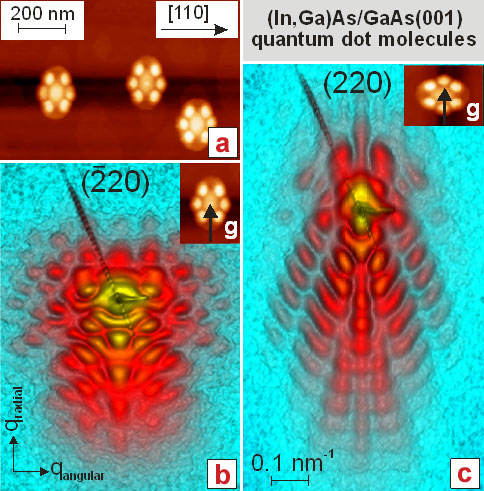- Home
- News
- Spotlight on Science
- Hexapod quantum...
Hexapod quantum dot molecules probed by grazing-incidence diffraction
26-05-2008
Quantum dot molecules are formed by the self assembly of individual quantum dots. The electronic properties of these semiconductor nanostructures depends on the shape and strain of the structure. In this study the elastic strain within (In,Ga)As/GaAs(001) quantum dot molecules made of six quantum dots was investigated using grazing incidence X-ray diffraction.
Share
An interesting development in the self-assembly of semiconductor nanostructures is the growth of quantum dot molecules (QDMs). These are local arrangements of a small number (2 to 8) of individual quantum dots (QDs). Besides the most simple, the prototypical QDM containing just two QDs [1], more sophisticated QDMs made of three, four or even six QDs can be produced [2]. All the different types (bi-QDMs, and multi-QDMs) can be considered as building blocks for future quantum computational devices, e.g. [3].
Here we focus on the elastic strain within non-artificial (In,Ga)As/GaAs(001) multi-QDMs containing up to 7 QDs. This strain is related to the local chemical composition. The QDMs fully self-assemble around nanoscale-sized GaAs mound-like templates, which have been grown by so-called droplet homoepitaxy on GaAs(001). Due to their three-dimensional nature, the crystal lattice at those nucleation spots can elastically relax and thus provide energetically favourable conditions for further (heteroepitaxial) growth. Depending on the specific InAs monolayer coverage, the number of QDs per GaAs mound ranges from two to six. As an example, Figure 1a depicts an atomic force micrograph of hexapod-like QDMs. The structural asymmetry with respect to the different <110> directions already hints at an effect of strain on the final morphology, which becomes clearly visible at the diffusely scattered X-ray intensity measured near the different (220) grazing incidence reflections (Figure 1b and 1c). These experiments were carried out at beamline ID10B.
Grazing incidence diffraction (GID) can provide highly surface-sensitive information on, e.g., low-dimensional semiconductor nanostructures, since the angle of incidence is in the range of a few tenths of a degree, and the incoming X-ray wave field decreases exponentially inside the sample. Because the strained (In,Ga)As QDs within the QDMs progressively relax towards their apex, they establish a height-dependent gradient of the in-plane lattice constant. Conversely, the respective areas contribute to diffusely scattered intensity at different qradial (iso-strain scattering). Thus, intensity at small qradial refers to regions close to the QD apex, while larger values of qradial are due to areas closer to the substrate material.
Besides the different overall elongations (seen in Figure 1a), one may notice that there are two QDs in the [110] direction, since the corresponding locations along [1-10] are not occupied with QDs. This could be due to different diffusion lengths during the QDM growth, and/or different strain relaxation along [110] and [1-10].
 |
|
Figure 1. Hexapod-like (In,Ga)As/GaAs(001) quantum dot molecules. (a) atomic force micrograph, (b) grazing-incidence diffraction near the GaAs(-220) and (c) GaAs(220) substrate reflection where the main lateral directions of the hexapod quantum dot molecules are reflected. |
References
[1] M. Hanke, M. Schmidbauer, D. Grigoriev, P. Schäfer, R. Köhler, T.H. Metzger, Zh.M. Wang, Yu.I. Mazur, and G.J. Salamo, Appl. Phys. Lett. 89, 053116 (2006).
[2] J.H. Lee, Zh.M. Wang, N.W. Strom, Yu.I. Mazur, and G.J. Salamo, Appl. Phys. Lett. 89, 202101 (2006).
[3] H.J. Krenner, M. Sabathil, E.C. Clark, A. Kress, D. Schuh, M. Bichler, G. Abstreiter, and J.J. Finley, Phys. Rev. Lett. 94, 057402 (2005).
Authors
M. Hanke (a), M. Schmidbauer (b), P. Schäfer (c), J.H. Lee (d), Yu.I. Mazur (d), Zh.M. Wang (d), G.J. Salamo (d) and O. Konovalov (e).
(a) Martin-Luther-University Halle-Wittenberg, Halle (Germany)
(b) Institute for Crystal Growth, Berlin (Germany)
(c) Humboldt-University zu Berlin (Germany)
(d) University of Arkansas (USA)
(e) ESRF
What's related?
Beamline ID10B



